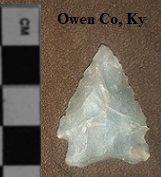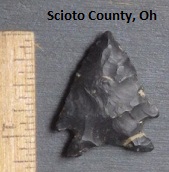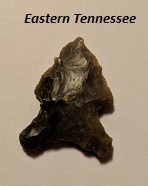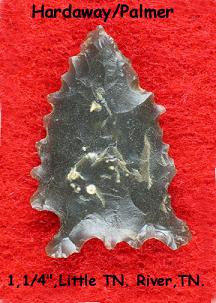Outline is Representative of Size and Shape:

Name Details:
Identified By: Joffre L. Coe
Named For: Type Site
Date Identified: 1964
Type Site: Hardaway Site, Stanly County, North Carolina
Identified By: Joffre L. Coe
Named For: Type Site
Date Identified: 1964
Type Site: Hardaway Site, Stanly County, North Carolina
Point Validity:
Valid type
Coe was a highly respected and pioneering anthropologist in North Carolina archaeology and a preeminent authority on eastern North American anthropology. This type was named in a professional publication and has many professional references. This is considered a valid type.
Hardaway - Palmer
Hardapalmer (Coe, 1970)Small Dalton (Morse and Morse, 1983)
Cluster:
Description of Physical Characteristics and Flaking Pattern:
This is a thin small to medium side notch point with a flattened to elliptical cross section. The blade is primarily excurvate, but may vary to straight. Parallel notches are generally deep and narrow forming a U appearance. The shoulders are primarily straight, but some examples have slightly barbed shoulders. The base is most commonly deeply concave, but may vary to concave. The base commonly has basal grinding. This point may have a bifurcated appearance. This point has a random flaking pattern.
Size Measurements:
Total Length - 28 to 50 mm (26 to 35 mm average), Blade Width - 14 to 25 mm (19 mm average), Thickness - 3 to 10 mm (average 8mm)
Total Length - 28 to 50 mm (26 to 35 mm average), Blade Width - 14 to 25 mm (19 mm average), Thickness - 3 to 10 mm (average 8mm)
Commonly Utilized Material:
The primary type of material is based on location, but commonly used materials include quartz, quartzite, cherts, flints, felsite, and jasper.
The primary type of material is based on location, but commonly used materials include quartz, quartzite, cherts, flints, felsite, and jasper.
Additional Comments:
The Hardaway type is believed to have evolved into the Palmer and the Kirk types. Many feel that this type is the intermediate between the Hardaway and the Palmer type. This type has the blade and shoulders commonly seen on the Palmer type, but has the concave base that is seen on the Hardaway type and is generally lacking in the Palmer type.
The Hardaway type is believed to have evolved into the Palmer and the Kirk types. Many feel that this type is the intermediate between the Hardaway and the Palmer type. This type has the blade and shoulders commonly seen on the Palmer type, but has the concave base that is seen on the Hardaway type and is generally lacking in the Palmer type.
Distribution: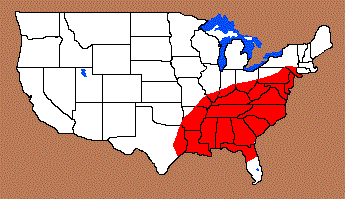
Distribution Comments:
This point is primarily found southern Virginia and into Mississippi. This point is found with less frequency from northern Virginia and north and western Mississippi and west.
This point is primarily found southern Virginia and into Mississippi. This point is found with less frequency from northern Virginia and north and western Mississippi and west.
Age / Periods:
Date: 10,000 - 9,000 B.P.
Cultural Period: Transitional Paleo
Glacial Period: Late Pleistocene to Early Holocene
Culture:
Date: 10,000 - 9,000 B.P.
Cultural Period: Transitional Paleo
Glacial Period: Late Pleistocene to Early Holocene
Culture:
Age Details:
Similar Points:
Alamance, Chipola, Dalton, Palmer, Patrick Henry, Russell Cave, San Patrice, Union Side Notch
Alamance, Chipola, Dalton, Palmer, Patrick Henry, Russell Cave, San Patrice, Union Side Notch
Other points in this cluster / Related / Associated Points:
Hardaway Blade, Hardaway Dalton, Hardaway, Palmer
Hardaway Blade, Hardaway Dalton, Hardaway, Palmer

